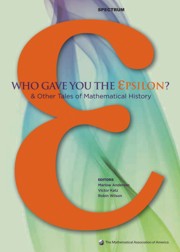Book contents
- Frontmatter
- Introduction
- Contents
- Analysis
- Geometry, Topology and Foundations
- Algebra and Number Theory
- Foreword
- Hamilton's Discovery of Quaternions
- Hamilton, Rodrigues, and the Quaternion Scandal
- Building an International Reputation: The Case of J. J. Sylvester (1814–1897)
- The Foundation Period in the History of Group Theory
- The Evolution of Group Theory: A Brief Survey
- The Search for Finite Simple Groups
- Genius and Biographers: The Fictionalization of Evariste Galois
- Hermann Grassmann and the Creation of Linear Algebra
- The Roots of Commutative Algebra in Algebraic Number Theory
- Eisenstein's Misunderstood Geometric Proof of the Quadratic Reciprocity Theorem
- Waring's Problem
- A History of the Prime Number Theorem
- A Hundred Years of Prime Numbers
- The Indian Mathematician Ramanujan
- Emmy Noether
- “ Marvelous Proof,”
- Afterword
- Surveys
- Index
- About the Editors
The Roots of Commutative Algebra in Algebraic Number Theory
from Algebra and Number Theory
- Frontmatter
- Introduction
- Contents
- Analysis
- Geometry, Topology and Foundations
- Algebra and Number Theory
- Foreword
- Hamilton's Discovery of Quaternions
- Hamilton, Rodrigues, and the Quaternion Scandal
- Building an International Reputation: The Case of J. J. Sylvester (1814–1897)
- The Foundation Period in the History of Group Theory
- The Evolution of Group Theory: A Brief Survey
- The Search for Finite Simple Groups
- Genius and Biographers: The Fictionalization of Evariste Galois
- Hermann Grassmann and the Creation of Linear Algebra
- The Roots of Commutative Algebra in Algebraic Number Theory
- Eisenstein's Misunderstood Geometric Proof of the Quadratic Reciprocity Theorem
- Waring's Problem
- A History of the Prime Number Theorem
- A Hundred Years of Prime Numbers
- The Indian Mathematician Ramanujan
- Emmy Noether
- “ Marvelous Proof,”
- Afterword
- Surveys
- Index
- About the Editors
Summary
Introduction
The concepts of field, commutative ring, ideal, and unique factorization are among the fundamental notions of commutative algebra. How did they arise? In large measure, from three central problems in number theory: Fermat's Last Theorem, reciprocity laws, and binary quadratic forms. In this paper we will describe how this happened.
To put the issues in a broader context, these three number-theoretic problems were instrumental in the emergence of algebraic number theory—one of the two main sources of the modern discipline of commutative algebra. The other source was algebraic geometry. It was in the setting of these two subjects that many of the main concepts and results of commutative algebra evolved in the nineteenth century. Thus commutative algebra can be said to have been well developed before it was created.
Commutative algebra is nowadays understood to be the study of commutative noetherian rings. The first book on the subject, dating from the 1950s, was Zariski and Samuel's Commutative Algebra. In the first decades of the twentieth century, what we understand as commutative algebra was known as Ideal Theory, a name which reflects the sources of the subject.
To set the scene for our story, a word about mathematics, and especially algebra, in the nineteenth century. The period witnessed fundamental transformations in mathematics—in its concepts, its methods, and in mathematicians' attitude toward their subject.
- Type
- Chapter
- Information
- Who Gave You the Epsilon?And Other Tales of Mathematical History, pp. 299 - 308Publisher: Mathematical Association of AmericaPrint publication year: 2009



